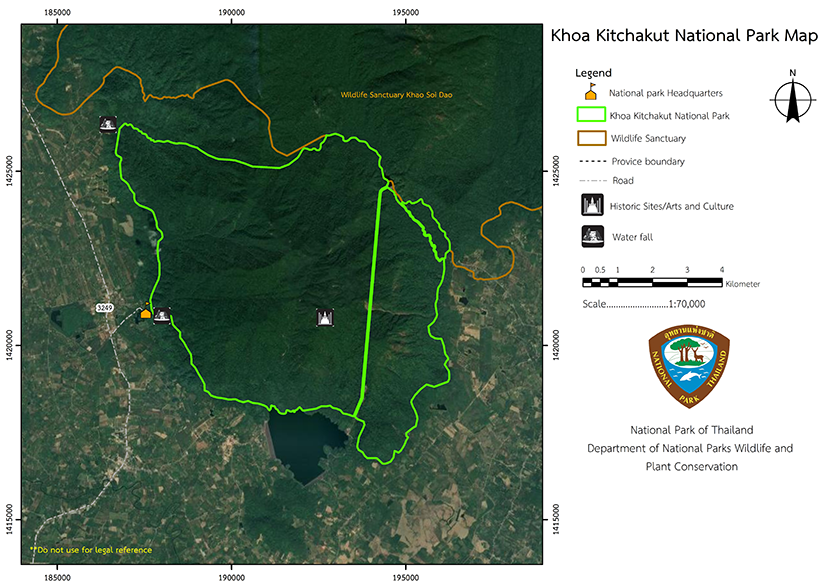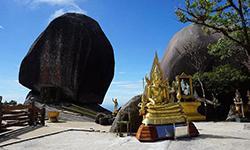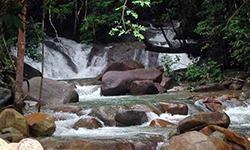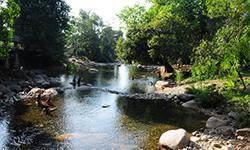Khao Khitchakut National Park
Contact Location : Khao Khitchakut National Park, Phluang Sub-district, Khao Khitchakut District, Chanthaburi Province, 22210
Telephone Number : (+66) 3 960 9666
Email : khaokhitchakut_np@hotmail.com
Facebook : KhaoKhitchakut National Park
Information
Khao Khitchakut National Park is located in Khao Khitchakut Forest or Khao Phra Bat Forest, in Makham and Khao Khitchakut District, Chanthaburi Province, and is composed of mountains with stunning scenery. The highest peak is at an altitude of 1,000 meters above sea level. It has beautiful natural features, such as Krathing Waterfall, and geological phenomena associated with Buddhist mythology, especially the religious beliefs about the Buddha's footprint. The Khao Khitchakut peak has an area of approximately 58.31 square kilometers, or 36,444.05 rai.
Background
In 1958, the President of the Association for the Conservation of Wildlife (ACW) wrote a letter to the Minister of Agriculture, proposing to preserve Khao Khitchakut forest, in Chanthaburi Province, as a habitat for animals and to establish it as national park. Therefore, the Royal Forest Department ordered the Si Racha and Chanthaburi Forestry Offices to proceed it and issued an order No. 852/2517 dated July 30, 1974, appointing Mr. Sompol Wannakul, a forestry technical officer, to conduct a preliminary survey. According to the survey results published on June 16, 2518, it contains a complex mountain landscape, beautiful natural features, including caves and waterfalls, and abundant wildlife, making it an ideal location for the establishment of a national park. The National Park Division of the Royal Forest Department then proposed to the National Park Board, which had a meeting resolution No. 2/2518 on October 22, 1975, deemed it appropriate to issue a royal decree designating the Khao Khitchakut forest area to be a national park.
The Royal Forest Department requested the revocation of the Khao Khitchakut Forest, which was classified as a National Reserved Forest according to Ministerial Regulation No. 49, published in the Government Gazette, Volume 82, Section 39, dated May 11, 1965. Therefore, it lost its National Reserved Forest status on September 7, 1976, as stated in the Government Gazette, Volume 93, Section 108.
Later, the Khao Khitchakut Forest was designated as a national park by a royal decree specifying that the Khao Khitchakut forest in the area of Takhian Thong, Chaman, Phluang, and Wang Sam Sub-district, Makham District, Chanthaburi Province, with an approximate 36,687 rai or 58.70 square kilometers, to be a national park, announced in the Government Gazette, Volume 94, Section 38, dated May 4, 1977. Thus, it is the 14th national park in Thailand.
Later, a royal decree revoked some areas of 242.95 rai or 0.38872 square kilometers, which were announced in the Government Gazette, Volume 115, Section 64 Ko, dated September 24, 1998, thus Khao Khitchakut National Park has the remaining area of 36,444.05 rai, or 58.31 square kilometers.
Note : After paying the entrance fee to the National Park, please carry the receipt for inspection.

36,444.05 rai (approximately 58.31 square kilometers)
|
Khao Phra Bat |
Krathing Waterfall |
||
|
|
|||
Nature trails ⇔ Visit Waterfall ⇔ Observe flowers/plants ⇔ Bird/Butterfly ⇔ Camping
Welfare shop : (coffee, desserts, drinks) is open daily from 08.00 - 17.30 hrs.
Mobile phone signal :
Headquarters: AIS, TRUE, DTAC
|
|
The general topography consists of steep mountains due to the elevation of the earth's crust. The base rock is an igneous rock, Jurassic granite, approximately 135 - 180 million years old. On the eastern side, it's very steep, with the ridgeline running from northwest to southeast. The southeastern foothills are gently sloping, with Khao Phra Bat, at approximately 1,085 meters above mean sea level, being the highest peak. There is a small plain in the west. On Khao Phra Bat, large and round stones are scattered everywhere, and a massive stone with Buddha's footprint is visible from the ground outside the national park. The high mountains of Khao Khitchakut National Park serve as the headwaters for several significant creeks, including Khlong Krathing, Khlong Takhian, Khlong Thung Ple, and Khlong Phluang, all of which are vital water sources for Chanthaburi River.
|
|
Khao Khitchakut National Park climate is influenced
|
|
|
|
Flora and Wildlife Wildlife is abundant because of the steep mountain terrain. Moreover, people who live near the national park do not poach since they already have a primary career with a good income from the orchards. Wild animals, such as Elephant, Bull, Fishing Cat, Asian Black Bear, Sambar Deer, Barking Deer, Serow, Sild Boar, Pileated Gibbon, East Asian Porcupine, Asian Palm Civet, Small Asian Mongoose, Burmese hare, Tupaia glis, Variable Squirrel, Lyle's Flying Fox, Chinese Francolin, Lewis' Silver Pheasant, Red JungleFowl, White-Breasted Waterhen, Thick-billed Green Pigeon, Greater Coucal, Indian Roller, Great Hornbill, White-Rumped Shama, Black-Crested Bulbul, Black-Drongo, Olive-Backed Sunbird, Yellow Tortoise, Common House Gecko, Tokay Gecko, Oriental Garden Lizard, Butterfly Lizard, Monitor Lizard, many-striped Skink, |
How to get there by car :
From Bangkok, take Bangna - Trat Road. At Khao Rai Ya Intersection, the milestone No. 324 th, turn right onto Bamrasnaradura Road for a distance of 21 kilometers; there will be a sign indicating the entrance to the National Park, which is close to the Rajamangala University of Technology Tawan-OK Chanthaburi Campus. Then turn right for another 1.5 kilometers; visitors will reach the National Park Headquarters in Phluang Sub-district, Khao Khitchakut District, Chanthaburi Province.
- National Park Ranger Station Kho Ko No. 1 (Phra Bat Phluang)
- National Park Ranger Station Kho Ko No. 2 (Khlong Phaibun)
Accommodations and facilities
Accommodation : Khitchakut 103 (Sanechan)
: Khitchakut 104 (Kritsana 1)
: Khitchakut 105 (Kritsana 2)
: Khitchakut 106 (Kritsana 3)
: Khitchakut 107 (Kritsana 4)
: Khitchakut 108 (Thepwana)



